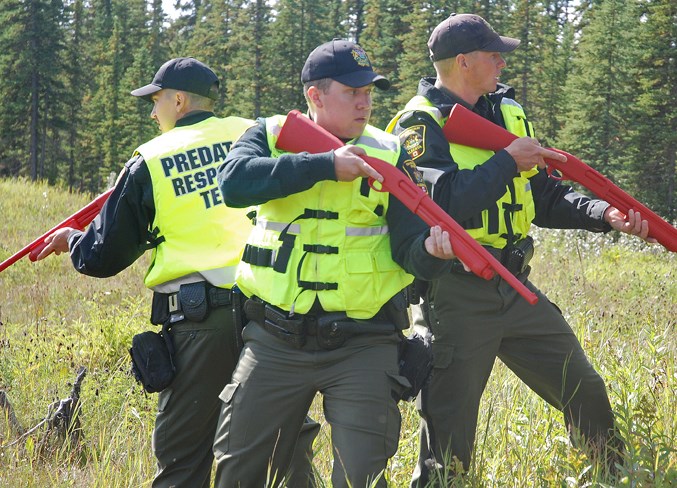Staged but realistic training scenarios are an important part of ensuring Fish and Wildlife officers are prepared to act confidently in the heat of an adrenalin-fuelled moment, says a regional problem wildlife specialist with Alberta Fish and Wildlife.
Although statistically speaking fairly uncommon, Mike Ewald said dangerous predator attacks on people are certainly not unheard of, especially in communities that encroach on nature’s doorstep.
Whether a lone hunter caught off guard by a bear deep in the bush, or a child playing in a rural property’s backyard when a cougar pounces from the trees, he said officers are trained to respond to a variety of potential attacks.
However, while classroom lessons teach an officer how to act in theory, actually physically going through the steps with a team substantially improves their ability to act confidently without hesitation and reduces the chances of fatal errors, he said.
“Public safety is our number 1 mandate,” said Ewald, who is based in Barrhead but provides training provincewide.
To that end, he said the agency strives to provide comprehensive training scenarios to as much as possible improve outcomes in the event of a reported predator attack.
Ewald was one of two lead instructors overseeing a three-day exercise in Sundre last week for about a dozen members of Fish and Wildlife’s Predator Response Team. There were also several other officers participating in the exercise learning how to become instructors. A similar program had been conducted the week prior in Whitecourt for the northern part of Alberta, while this course was offered for the southern portion of the province.
“I love doing this,” he said, stressing the importance of providing these kinds of training opportunities for newer officers.
“It’s good to be confident and comfortable in what you’re doing.”
The group stayed from Sept. 10-12 at the Mountainview Inn and Suites, where the days were broken up into classroom sessions followed by outdoor scenarios in the bush behind the berm near the Visitor Information Centre.
The dozen officers-in-training who took the course were split up into four teams of three, each taking turns tackling the realistically-staged exercises, he said.
“We have actors and role players played by other officers,” he said.
One of the scenarios involved responding to a call from a frantic mother, portrayed by an office administrator, whose child was attacked by a cougar and subsequently dragged out into the bush. The teams took turns tracking a trail of “blood” out into the trees, where they carefully proceeded in a tight formation watching one another’s backs until they found the victim, a mannequin doctored and dressed up to resemble a real casualty.
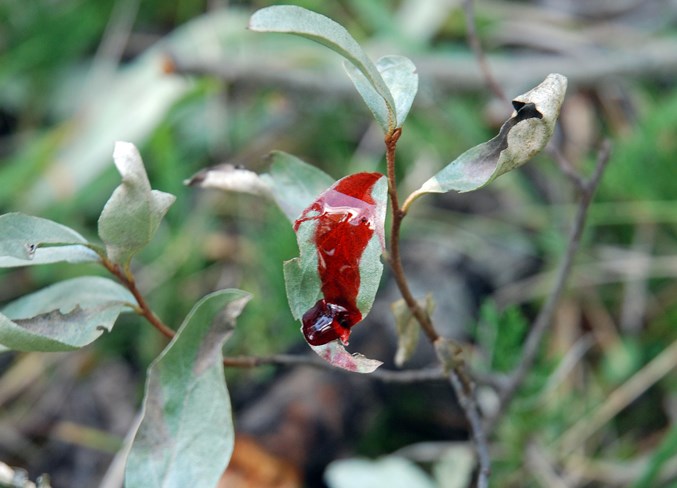 In one of the scenarios, the teams tracked a trail of “blood” into the trees to find the victim of a cougar attack. Simon Ducatel/MVP Staff
In one of the scenarios, the teams tracked a trail of “blood” into the trees to find the victim of a cougar attack. Simon Ducatel/MVP Staff
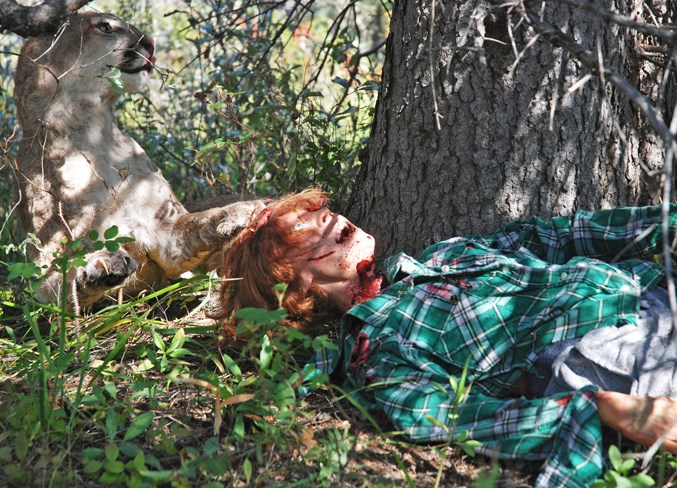 Although exceedingly rare, cougar attacks are an all-too-real possibility that Fish and Wildlife officers train to be prepared for.
Although exceedingly rare, cougar attacks are an all-too-real possibility that Fish and Wildlife officers train to be prepared for.
There was also an exercise involving a hypothetical situation wherein two men are in the bush working on transect lines — demarcating an area for logging or development — when one is attacked and killed by a grizzly bear. That scenario was more about clearing a scene for investigators, he said, adding both staged situations were inspired by real-life incidents.
Another component of the training, said Ewald, involved teaching officers how to tactically and safely neutralize a predator on top of a person by making sure to keep their firearms as low to the ground as possible with the barrels pointed up to bring the animal down without killing their own member. The drills help to build muscle memory so officers' reactions come as second nature, he said.
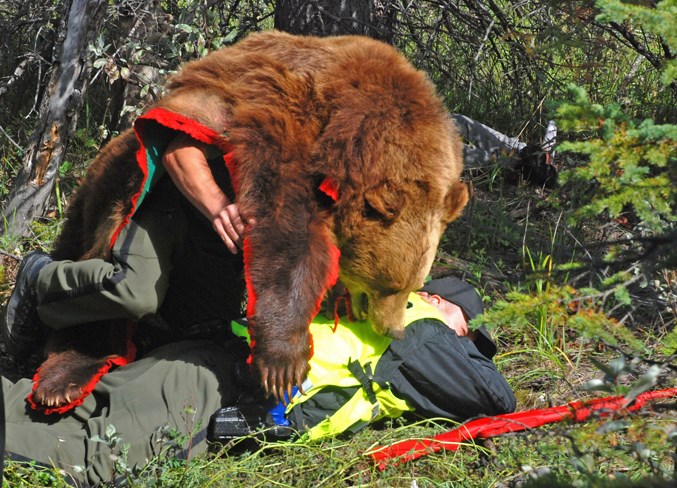 Fish and Wildlife officer Aaron Szott got “attacked” by a “grizzly bear” while guarding the victim of a cougar attack, prompting his teammates that were in pursuit of another cougar to immediately rush back to his aid. Simon Ducatel/MVP Staff
Fish and Wildlife officer Aaron Szott got “attacked” by a “grizzly bear” while guarding the victim of a cougar attack, prompting his teammates that were in pursuit of another cougar to immediately rush back to his aid. Simon Ducatel/MVP Staff
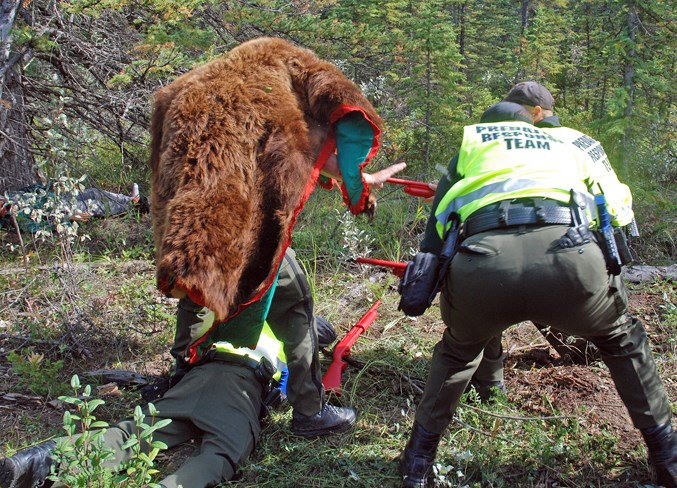 Fish and Wildlife officers are trained to bring their firearms as low as possible and to point their barrels upwards when neutralizing a predator that is on top of a person. Simon Ducatel/MVP Staff
Fish and Wildlife officers are trained to bring their firearms as low as possible and to point their barrels upwards when neutralizing a predator that is on top of a person. Simon Ducatel/MVP Staff
Also included in the training is the human aspect of such situations, with survivors of predator attacks offering the officers insight on their harrowing experiences, he said.
“That empathy is important for officers to have. Officers taking the course get the true feeling of the emotional trauma that goes on for survivors.”
Members with Western Canadian Law Enforcement Academy were also present during the exercise to provide additional information.
Ewald added there are several key messages for the public as well.
“These attacks are extremely rare,” he stressed.
Throughout Alberta’s history, he said there has been only one recorded cougar attack-related fatality, dating back to the 1990s in Canmore.
“Far more people are killed by domestic dogs,” he said, adding that doesn’t discourage people from buying bigger breeds as pets. The presence of cougars also should not deter people from enjoying the outdoors, he said.
“I’m far more at risk walking across the street in Sundre and getting run over than getting attacked in the bush.”
While there have been several bear attack-related fatalities over the years, even those encounters are relatively rare, he said.
Of course anyone venturing out to hike, hunt or camp should be well informed about the area they intend to explore, he said.
“The more information they can obtain about the area, the more enjoyable the experience will be for everybody involved.”
But spotting a predator in its natural habitat does not necessarily present a threat of imminent danger, he said.
“Give them their space and respect they deserve,” he said, adding, “and just enjoy the experience.”
But if a dangerous predator is observed in a location that creates a public safety concern, Ewald urges people to immediately call the Report A Poacher line at 1-800-642-3800.
“We have special training to deal with these situations,” he said.
“We are a calming influence out there.”
